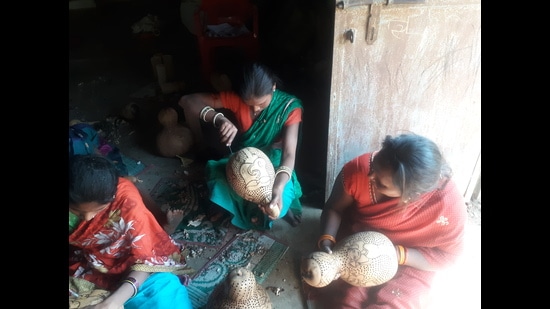It took two days before Meeta Raheja finally gave in. She’d been eyeing a Diwali lantern at a crafts exhibition at the Chhattisgarh Tribal Dance Festival, held in Raipur in November. It cost ₹3,500, but it wasn’t the price tag that was holding her back. “I have so many lanterns at home. I really didn’t need another one,” says the Delhi-based founder of a PR agency.
This one, however, was special. It was made from tuma, a local wild bottle gourd that is grown in Chhattisgarh, aged for two months on the vine and painstakingly turned into artistic objects by the tribal craftsmen. The gourd itself has a bitter taste – few households cook it. But hardened and dried, it makes for a surprisingly leathery, pliable material to work with, and perfect for carving. Raheja’s pick, a hanging lantern about 30 centimetres long, had little circles carved into it. When illuminated, it cast a soft glow, much like a stationary disco ball. “How can you resist something that looks so good and is handmade,” Raheja says.
Dried, hollowed out tumas have traditionally served as containers to store water, grains and juices. Today, artisans are also fashioning them into lamps, jewellery, toys, cutlery, boxes and other craft items. “The practice began 15 to 20 years ago, when some artists started experimenting with tuma,” says Sunil Vishwakarma, 22, who won the Kamladevi Puraskar, an annual award by the Delhi Crafts Council, for excellence in crafts, in 2014.
Vishwakarma belongs to a family of craftspeople who traditionally create dhokra, decorative and utilitarian objects made from non–ferrous metal using wax casting techniques. His father, Kashiram Vishwakarma, was amongst the first craftsmen to start working with tuma to make craft objects. Their early experiments were promising – the works found many takers at exhibitions in Mumbai, Delhi, Chennai and Kolkata, and got recognised by crafts lovers.

In the last few years, as the craft has become better known, artisans have been getting orders from across the country. K Monika, head of women’s self-help group Software Organisation, from Bastar, Chhattisgarh, has trained 30 rural women in creating tuma products art. The items are sold through the organisation’s social media handle, and to tourists who visit their centre. “People love it for its simplistic beauty and because it is made by the local tribal people,” she says. “We have also been innovating with designs and fusing shells, wrought iron and Chhattisgarh’s specialty tussar silk to make different products.”
Jugri Kashyap, 40, from Narayanpal village, 282 kilometres from Raipur, joined the organisation and learnt how to make tuma products a year ago. She had 15 other women have since earned ₹30,000 in profits, which they share. “I used to work as a farm labourer, earning ₹2,500 a month. Today, my income has doubled to ₹4,500 from making tuma products,” says Kashyap. “I use the money for my daughter’s education and for household expenses.”
The pandemic has slowed things down, as many crafts exhibitions, a major sales platform for artisans, are being cancelled. “We know that tuma art has a lot of potential and we are now focusing on creating online platforms to promote and sell tuma crafts,” says Vishwakarma.
Enjoy unlimited digital access with HT Premium
Subscribe Now to continue reading

Stay connected with us on social media platform for instant update click here to join our Twitter, & Facebook
We are now on Telegram. Click here to join our channel (@TechiUpdate) and stay updated with the latest Technology headlines.
For all the latest Art-Culture News Click Here
